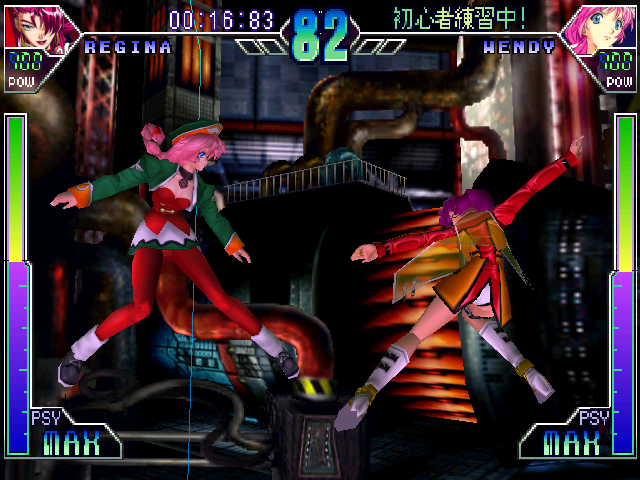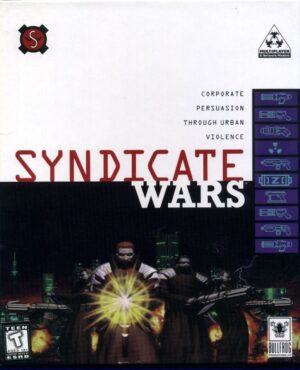Retro Replay Review
Gameplay
Psychic Force 2012 builds its entire combat system around free-form, three-dimensional dogfights inside a massive floating cube. Instead of being confined to a flat plane, you can soar in any direction, engage at long range with energy blasts or close in for brutal melee combos. Each character’s guard, weak attack and strong attack respond differently depending on your distance from the opponent, encouraging you to master spatial positioning as much as button-mashing.
At the heart of each match lies the Power Meter, a resource that governs your access to devastating special moves. Firing off a signature psychic burst or harnessing your weapon’s full potential drains this bar, forcing you to choose between conserving power for defense or unleashing a high-impact offense. Interestingly, taking damage actually expands your maximum Power Meter, creating risk-reward scenarios where a skilled player can reverse the tide by remaining aggressive even when low on health.
Character variety further spices up the gameplay. From Regina’s telekinetic whips to Genshin’s gravity-well traps, each fighter brings a distinct arsenal of projectile attacks, defensive techniques and mid-air weapon strikes. Mastering one hero doesn’t necessarily translate to mastery of another, which adds a strong incentive to experiment across the full roster of ten psychic warriors.
Modes are straightforward but plentiful. Training mode gives a no-penalty environment to drill combos, versus mode lets you face off against friends or CPU, and the story mode threads together static anime-inspired stills with in-engine cinematic moments. Though the narrative presentations can feel sparse, they at least provide context and motivation for diving back into the cube time and again.
Graphics
When Psychic Force 2012 originally hit arcades, its bold use of vivid colors and crisp, polygonal arenas made a strong first impression. The floating cube stages are adorned with dynamic backgrounds that shift as you fight, giving an almost hypnotic sense of vertigo as your combatants zip between six distinct walls. Particle effects—sparks from energy clashes, glows around special moves—help each encounter pop with kinetic flair.
Character models strike a balance between anime stylization and functional readability. Each psychic warrior is designed with clear silhouettes and recognizable color schemes, which is crucial when you’re tracking airborne foes in all three dimensions. Textures are simple but effective, ensuring smooth performance in high-speed duels without sacrificing visual clarity.
The later PlayStation port, rebranded Psychic Force 2, inevitably suffered some graphical degradation. Textures appear blurrier, polygon counts are lower, and a few lighting effects were dialed back to maintain steady framerate on console hardware. While die-hard fans may lament the loss of arcade-perfect visuals, the port remains serviceable—especially if you prioritize portability over pixel-perfect fidelity.
Notably, the PS version compensates with a brand-new anime intro that ties together the game’s core conflict in a splashy, hand-drawn sequence. Though it doesn’t alter in-game graphics, the cinematic opening adds a fresh sense of polish and spectacle that helps offset some of the trade-offs made for home play.
Story
Psychic Force 2012’s narrative orbits around two ideological factions: one group of psychics dedicated to peaceful coexistence with humanity, and a rival sect convinced psychics should dominate the world. Caught in the middle are several neutral parties whose personal loyalties and backstories add layers of intrigue to each matchup. As you conquer opponents in story mode, static anime-style illustrations and short in-engine cutscenes unfold, revealing the tangled motivations behind each warrior’s cause.
While the story sequences lack full animation, their art direction captures the essence of classic 90s anime—dramatic close-ups, comically exaggerated expressions and dynamic panel layouts. Dialogue occasionally veers into melodrama, but it remains entertaining, and the brevity of each segment keeps the pace brisk, rarely overstaying its welcome between bouts.
Unique character endings further enrich the narrative tapestry. Defeating the final boss with different fighters yields alternate resolutions that shed light on how each psychic’s philosophy integrates (or clashes) with the broader conflict. For completionists, chasing all the epilogues provides a satisfying incentive to explore every fighter’s story path.
The PlayStation version supplements the original storyline with unlockable cutscenes in the Psy-Expand mode, a special challenge gauntlet that teaches you advanced techniques. These bonus vignettes not only deepen your understanding of each character’s psyche but also deliver extra lore tidbits that hardcore fans will appreciate.
Overall Experience
At its core, Psychic Force 2012 offers a refreshing twist on the fighting-game formula. The freedom to fly in all directions, the importance of resource management via the Power Meter, and the distinct arsenals each character wields make every duel feel unique. Matches are quick to learn yet hard to master, striking a satisfying balance for both casual players and competitive enthusiasts.
Graphically, the arcade original remains a standout thanks to its crisp environments and flashy effects, while the PlayStation port makes sensible compromises to keep the game running smoothly on home hardware. The added anime intro and Psy-Expand challenges sweeten the deal, though purists may still prefer the unabridged arcade visuals.
Story mode won’t win awards for narrative depth, but its brisk pacing, appealing art style and multiple endings deliver enough context to keep you invested in the psychic war. Combined with training and versus modes, Psychic Force 2012 provides ample reason to keep returning to the cube.
Ultimately, Psychic Force 2012 succeeds as an accessible yet deep one-on-one fighter with a distinctive aerial twist. Whether you’re drawn in by the high-octane psychic battles, the eclectic cast of characters or the novel 3D arenas, this sequel is well worth exploring—especially if you crave a fighting game that breaks free from the confines of a flat stage.
 Retro Replay Retro Replay gaming reviews, news, emulation, geek stuff and more!
Retro Replay Retro Replay gaming reviews, news, emulation, geek stuff and more!







Reviews
There are no reviews yet.